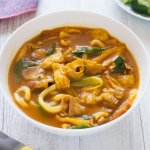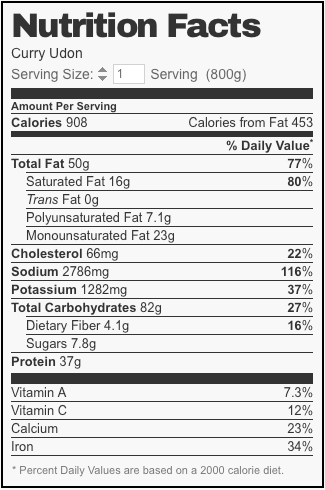
This is not just a simple bowl of udon noodles but curry flavoured noodles with pork, shallots (scallions), aburaage (deep fried tofu) and fish cakes. I made the curry sauce from scratch and flavour is amazing. Omit meat and fish cakes and make it a vegetarian version of curry udon with konbu dashi stock.
- 2 servings of fresh udon noodles (note 1)
- 4 shallots (scallions)
- 2 short chikuwa sticks (note 2)
- 1 aburaage
- 150 g pork belly , thinly sliced into bite size pieces (note 3)
- 700 ml dashi stock
- 1 tsp oil
- Salt & pepper
-
Cut shallots diagonally into about 5cm (2”) long pieces. Slice chikuwa diagonally into 4 cm long, 5mm (3/16”) wide pieces.
-
Pour boiling water (not in ingredients) over the aburaage to remove excess oil and squeeze moisture out. Cut the aburaage into two lengthwise, then cut them crosswise into 1.5 - 2cm (½”) wide pieces.
-
Add all the Curry Mixture ingredients to a bowl and mix well using a whisk, ensuring that corn flour is dissolved.
-
Add oil to a large fry pan or a saucepan and heat over medium high heat. Add pork, season with a pinch of salt and pepper, and cook for 1-2 minutes until the pork pieces are nearly cooked.
-
Add shallots, chikuwa and aburaage to the pan and cook further 30 seconds.
-
Add dashi stock and turn the heat up to high. When it starts boiling, scum might surface. Remove as much as possible.
-
Mix the curry mixture in the bowl again ensuring that corn flour has not collected at the bottom of the bowl. Add the mixture to the pan and turn down the heat to medium.
-
The sauce will start to thicken. When the sauce starts boiling, turn the heat off.
-
Transfer heated udon noodles to two serving bowls and pour curry sauce over the udon.
-
Serve immediately.
-
Boil water in a sauce pan that is large enough to blanch 2 servings of udon noodles.
-
Add udon noodles and boil until the water starts bubbling again or follow the instruction on the pack. Drain (note 5).
1. You can use dried udon noodles if you can't find fresh noodles. Follow the instructions on the package to boil dried noodles.
Fresh udon noodles and dried udon noodles can be purchased at super market and Asian/Japanese grocery stores.
2. Chikuwa is a log-shaped grilled fish cake with a hole in the middle. There are thick, large chikuwa that usually come in a pack of two and small, thin chikuwa, five in a pack. I used three short ones. If you would like to see a photo of the short chikuwa pack, please visit Oden (Simmered One Pot Dish).
Chikuwa is sold at Japanese/Asain grocery stores and comes frozen.
3. You can use other parts of pork or chicken. In both cases slice thinly and cut into bite size pieces. It is rare to use beef. If you are using lean meat, you may need to add a bit more oil when cooking.
4. Alternatively, you can use the microwave to heat the udon up if the udon package indicates so. My udon needed a couple of minutes in the microwave to heat up. Ensure that the vacuum sealed bag is opened to let the steam out while heating.
Udon noodles heated in microwave are slightly softer than the noodles blanched in boiling water.
5. Drain well as excess water will make the broth thin.
6. I could not obtain the nutrition information for chikuwa sticks so I substituted it with fish cake to obtain nutrition figures. There are some differences in nutritional values between these ingredients but differences seem to be not significant.
